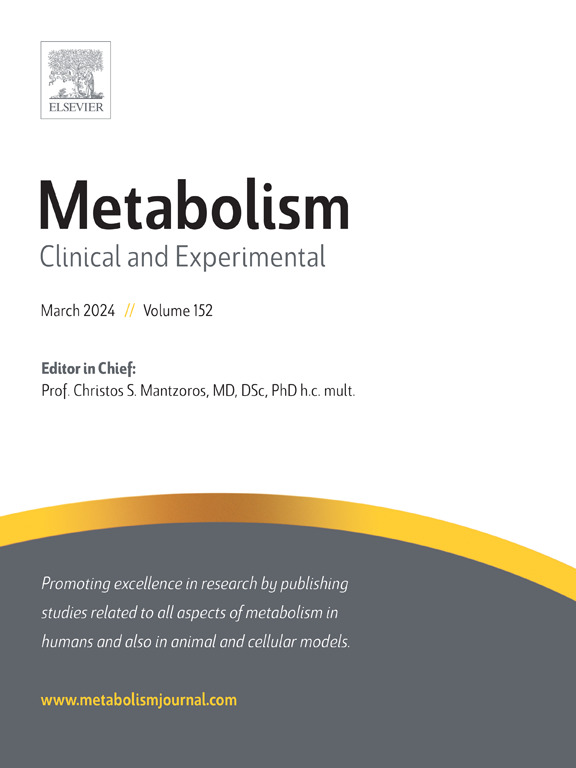Subphenotypes of body composition and their association with cardiometabolic risk – Magnetic resonance imaging in a population-based sample
IF 10.8
1区 医学
Q1 ENDOCRINOLOGY & METABOLISM
引用次数: 0
Abstract
Background
For characterizing health states, fat distribution is more informative than overall body size. We used population-based whole-body magnetic resonance imaging (MRI) to identify distinct body composition subphenotypes and characterize associations with cardiovascular disease (CVD) risk.
Methods
Bone marrow, visceral, subcutaneous, cardiac, renal, hepatic, skeletal muscle and pancreatic adipose tissue were measured by MRI in n = 299 individuals from the population-based KORA cohort. Body composition subphenotypes were identified by data-driven k-means clustering. CVD risk was calculated by established scores.
Results
We identified five body composition subphenotypes, which differed substantially in CVD risk factor distribution and CVD risk. Compared to reference subphenotype I with favorable risk profile, two high-risk phenotypes, III&V, had a 3.8-fold increased CVD risk. High-risk subphenotype III had increased bone marrow and skeletal muscle fat (26.3 % vs 11.4 % in subphenotype I), indicating ageing effects, whereas subphenotype V showed overall high fat contents, and particularly elevated pancreatic fat (25.0 % vs 3.7 % in subphenotype I), indicating metabolic impairment. Subphenotype II had a 2.7-fold increased CVD risk, and an unfavorable fat distribution, probably smoking-related, while BMI was only slightly elevated. Subphenotype IV had a 2.8-fold increased CVD risk with comparably young individuals, who showed high blood pressure and hepatic fat (17.7 % vs 3.0 % in subphenotype I).
Conclusions
Whole-body MRI can identify distinct body composition subphenotypes associated with different degrees of cardiometabolic risk. Body composition profiling may enable a more comprehensive risk assessment than individual fat compartments, with potential benefits for individualized prevention.
身体组成的亚表型及其与心脏代谢风险的关联——磁共振成像在一个基于人群的样本中。
背景:在描述健康状态时,脂肪分布比整体体型更能提供信息。我们使用基于人群的全身磁共振成像(MRI)来识别不同的身体组成亚表型,并表征与心血管疾病(CVD)风险的关联。方法:通过MRI测量以人群为基础的KORA队列中n = 299名个体的骨髓、内脏、皮下、心脏、肾脏、肝脏、骨骼肌和胰腺脂肪组织。通过数据驱动的k-均值聚类鉴定体组成亚表型。CVD风险通过建立的评分来计算。结果:我们确定了五种身体组成亚表型,它们在CVD危险因素分布和CVD风险方面存在很大差异。与具有有利风险的参考亚型I相比,两种高危表型iii和v的CVD风险增加了3.8倍。高危亚表型III增加骨髓和骨骼肌脂肪(26.3 % vs 11.4 %亚表型I),表明衰老的影响,而亚表型V显示整体高脂肪含量,特别是胰腺脂肪升高(25.0 % vs 3.7 %亚表型I),表明代谢障碍。亚表型II的心血管疾病风险增加2.7倍,脂肪分布不利,可能与吸烟有关,而BMI仅略有升高。在相当年轻的个体中,亚表型IV有2.8倍的CVD风险增加,这些个体表现为高血压和肝脂肪(17.7 % vs 3.0 %)。结论:全身MRI可以识别与不同程度的心脏代谢风险相关的不同身体组成亚表型。身体成分分析可能比单独的脂肪区室更能进行全面的风险评估,对个体化预防有潜在的好处。
本文章由计算机程序翻译,如有差异,请以英文原文为准。
求助全文
约1分钟内获得全文
求助全文
来源期刊

Metabolism: clinical and experimental
医学-内分泌学与代谢
CiteScore
18.90
自引率
3.10%
发文量
310
审稿时长
16 days
期刊介绍:
Metabolism upholds research excellence by disseminating high-quality original research, reviews, editorials, and commentaries covering all facets of human metabolism.
Consideration for publication in Metabolism extends to studies in humans, animal, and cellular models, with a particular emphasis on work demonstrating strong translational potential.
The journal addresses a range of topics, including:
- Energy Expenditure and Obesity
- Metabolic Syndrome, Prediabetes, and Diabetes
- Nutrition, Exercise, and the Environment
- Genetics and Genomics, Proteomics, and Metabolomics
- Carbohydrate, Lipid, and Protein Metabolism
- Endocrinology and Hypertension
- Mineral and Bone Metabolism
- Cardiovascular Diseases and Malignancies
- Inflammation in metabolism and immunometabolism
 求助内容:
求助内容: 应助结果提醒方式:
应助结果提醒方式:


